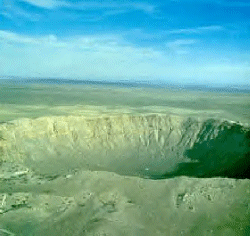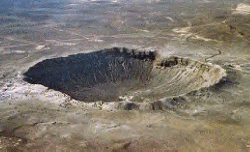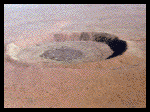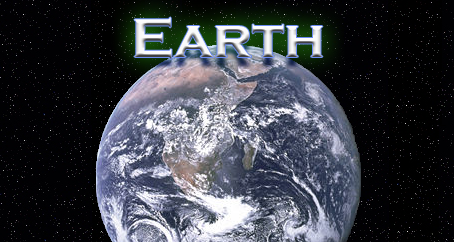Earth's Visitors from Space

This page probably isn't as exciting as you thought it was going to be! Instead of talking about alien visitors from outer space, I'll be talking about visits to Earth by rocks. Thrilling!! For all of the Earth's existence, it has been under constant attack by rocks flying around space. These rocks are meteoroids. Most burn up in Earth's atmosphere, but some get through and hit the surface and form craters.
Meteoroids, Meteors and Meteorites
Although a meteoroid, meteor and meteorite is pretty much the same thing, its name changes slightly depending on what its status is. It is known as a meteoroid while it is flying around space. A meteoroid could be a piece of rock that has broken off another object, like an asteroid, comet, moon or another planet. If the meteoroid enters Earth's atmosphere, it forms a fiery tail as it burns up as it plummets to the surface. Its proper name when it is travelling through the atmosphere of Earth is a meteor, but it may also be down as a falling star or shooting star. If the meteor hasn't completely burned up during its journey through Earth's atmosphere, it will hit Earth's surface and cause a crater. When it does, the remaining rock is known as a meteorite. So basically, if it's in space, it's a meteoroid, if it's in the sky, it's a meteor, and if it's on the surface of Earth, it's a meteorite

Above is the Barringer Crater in Arizona, USA. It was formed by a meteorite which hit Earth between 25,000
to 50,000 years ago and is 175 metres deep and 1265 metres wide.

This is the Wolfe Creek crater from Australia. It is 875 metres and 50 metres deep (although it has a "wall"
which is 25 metres high above the surface). It is believed that the meteorite that caused this crater hit the surface of Earth 300,000
years ago.
Craters are very prominent on the surfaces of the Moon and on planets like Mars and Mercury. This is through
millions of years of impacts from meteorites. However, there are just as many rocks
flying into Earth as into the Moon, Mars and Mercury, perhaps even more because Earth is larger
than them.
The reason that Earth's surface isn't covered by impact craters is the most meteoroids heading for Earth
burn up in the planet's atmosphere and don't survive long enough to hit the
surface. Also, the craters of those that do reach the surface are erased over
time due to Earth's constant geological, tectonic (the movement of Earth's
plates) and weathering processes. There are only about 120 craters recognised on
Earth and these are all relatively new when you consider the planet is 4.6
billion years old. On the Moon and on planets like
Mars and Mercury, there are no
geological processes so these worlds are covered by meteorite craters which have
been there for billions of years.
